Statement on Monetary Policy – August 2018 Box A: Financial Market Resilience of Emerging Asia
Since earlier this year, most emerging market economies have experienced tighter financial conditions. In this context, this box takes stock of recent financial market and economic developments in several economies in south and south-east Asia – namely India, Indonesia, Malaysia, Thailand and the Philippines (hereafter ‘emerging Asia’).[1] Together, these economies account for around 12 per cent of Australia's exports, comparable to Japan's share. These are also the financial markets in emerging Asia in which international investors are most active.
While most emerging markets have experienced asset price declines, exchange rate depreciations (relative to the US dollar) and outflows of foreign capital of late (Graph A1), these developments have tended to be more pronounced in economies with significant economic, financial or institutional vulnerabilities (see ‘The International Environment’ chapter). Compared with other regions, emerging Asian economies have generally been less affected by the tightening in external financing conditions.
In part, the more modest effect of the tighter external financing environment on emerging Asian economies reflects efforts by policymakers to build more resilient institutions, economies and financial systems in the two decades since the Asian financial crisis. While an in-depth analysis of resiliency is beyond the scope of this box, several key indicators have been a particular focus of financial markets:[2]
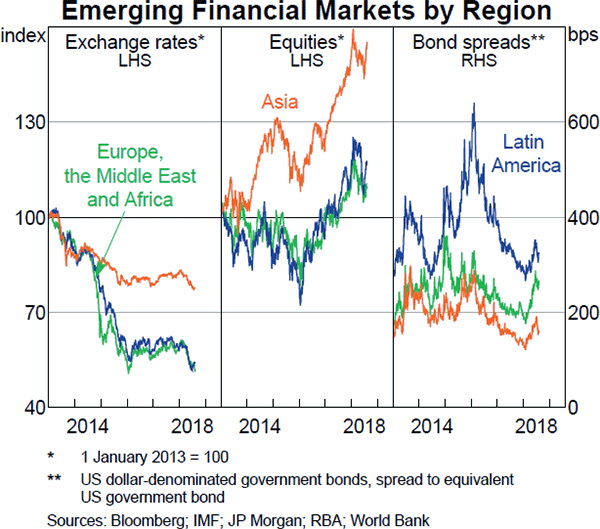
- Economic growth in these economies has been faster and more stable than growth in emerging economies in other regions in recent years (Graph A2). This partly reflects the region's stronger economic links to China and robust domestic demand compared with other emerging market economies. Also, in these emerging Asian economies it has generally been the case that inflation has remained low, real exchange rates have been broadly consistent with economic fundamentals and monetary policy has generally remained accommodative.[3] Moreover, with generally modest levels of public debt, fiscal policy in emerging Asia has been regarded as having scope to respond to growth shocks, should they materialise.
- Economies in emerging Asia run either current account surpluses (that is, they save more than they invest) or modest deficits (Graph A3). Accordingly, they are less reliant on net inflows of foreign capital, which can reverse sharply during times of market stress. Since the start of the year, the currencies of emerging economies with large current account deficits, such as Argentina and Turkey, have generally depreciated the most.
- Measures of the adequacy of foreign exchange reserves are generally higher for emerging Asia than for other key emerging market economies (Graph A4). Foreign exchange reserves enable authorities to intervene in foreign exchange markets to support market functioning or moderate the pace of exchange rate depreciation during periods of stress. Moreover, since the early 2000s, emerging Asian economies have generally moved towards more flexible exchange rate regimes. This can facilitate economic rebalancing in the event of external shocks, thereby reducing the need to maintain large foreign exchange reserves. The authorities have also encouraged the development of financial instruments to manage exchange rate risk.
- The amount of short- and long-term debt (sovereign and private) held by foreign investors, relative to the size of the overall economy, is generally lower in emerging Asia than in other emerging economies (Graph A5). Malaysia is the main exception.[4] Importantly, the portion of debt denominated in foreign currencies also tends to be lower in emerging Asia than elsewhere. Such debt, if unhedged, can be problematic because the burden of foreign currency-denominated debt becomes larger in local currency terms when the local currency depreciates.
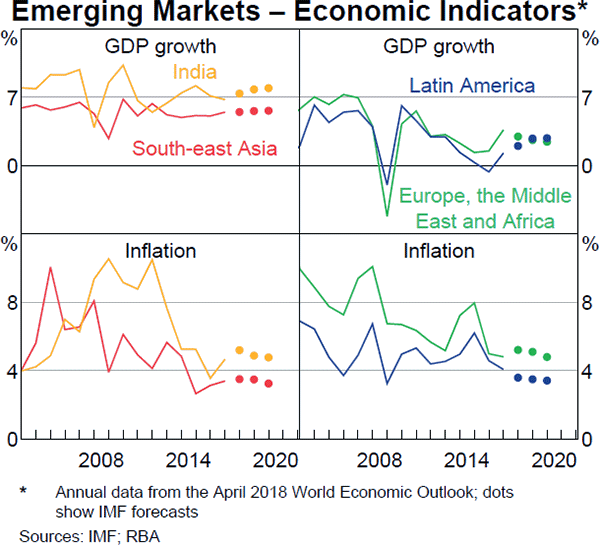
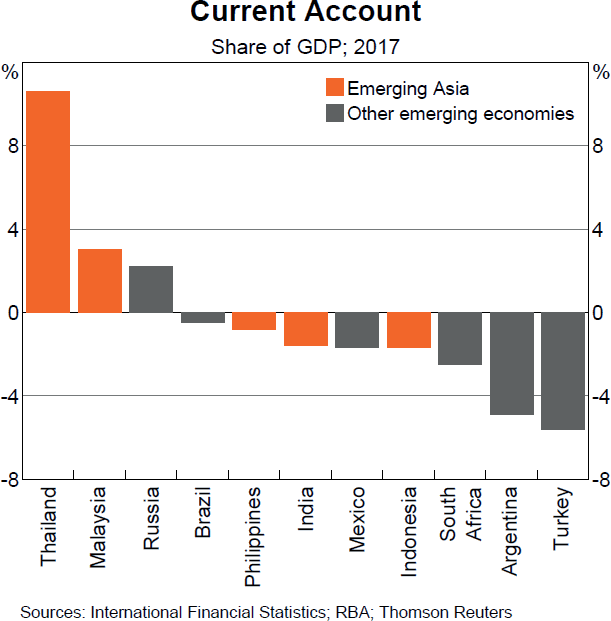
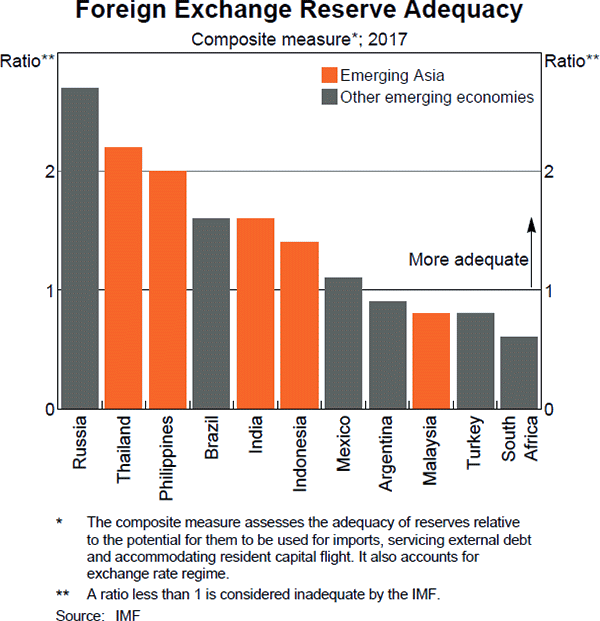
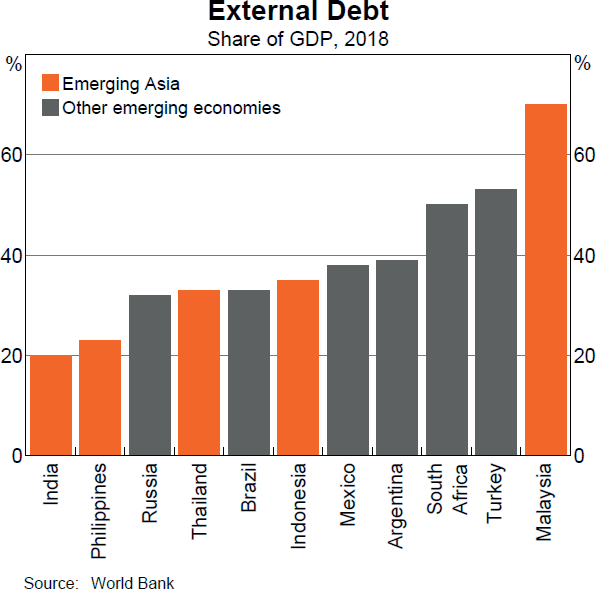
The policy response in emerging Asia to capital outflows this year has varied. Bank Indonesia has increased its policy rate by 100 basis points (despite inflation remaining around the midpoint of its target band) and intervened in the foreign exchange market to limit volatility. At the same time, Bank Indonesia has purchased domestic government bonds and eased macroprudential policy to limit the tightening in broader credit conditions from higher policy rates. The central banks in India and the Philippines increased policy rates, but have stated that this was mostly to address rising inflationary pressures at a time of strong domestic demand. Also, the Reserve Bank of India may have intervened in the foreign exchange market.[5] However, policymakers in other regional economies have generally accommodated the depreciation of exchange rates and declines in financial asset prices to date, as have those in the more industrialised economies of north-east Asia.
While emerging Asian economies have held up relatively well this year in the face of tighter external financing conditions, other types of external shocks may be more problematic. Reflecting the region's strong economic and financial linkages to China, a significant increase in trade protectionism and/or a sharp slowdown in Chinese economic growth represent downside risks to regional economic growth that bear close monitoring in the period ahead.
Footnotes
China is excluded from this analysis, given its large size (which warrants separate analysis) and limited capital account openness relative to most other economies in the region. The Chinese financial system and capital account have been the subject of several related articles, such as Bowman J, M Hack, and M Waring (2018), ‘Non-Bank Financing in China’, RBA Bulletin, March, viewed 16 July 2018. McCowage M (2018), ‘Trends in China's Capital Account’, RBA Bulletin, June, viewed 16 July 2018. [1]
There is a large literature that attempts to identify indicators of vulnerability to external shocks. For simplicity, we have chosen to focus on a handful of key metrics. We also acknowledge the difficulty associated with identifying thresholds for these indicators above or below which countries become vulnerable to crises. [2]
For details on the consistency of real exchange rate valuations with fundamentals see International Monetary Fund (2018), ‘External Sector Report’, July. [3]
Roughly one-third of Malaysia's external debt is denominated in local currency and around half has a medium-term maturity, which helps to reduce foreign exchange rate and rollover risks. Most of Malaysia's short-term foreign currency debt has been issued by the banking sector, a sizeable portion of which is hedged by short-term foreign currency assets. [4]
As a significant net importer of oil, India's external and fiscal positions are somewhat tied to oil prices. [5]